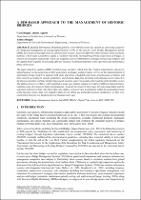Chapter A BIM-Based Approach to the Management of Historic Bridges
| dc.contributor.author | Biagini, Carlo | |
| dc.contributor.author | Aglietti, Alberto | |
| dc.contributor.author | Bongini, Andrea | |
| dc.date.accessioned | 2024-04-02T15:47:33Z | |
| dc.date.available | 2024-04-02T15:47:33Z | |
| dc.date.issued | 2023 | |
| dc.identifier | ONIX_20240402_9791221502893_103 | |
| dc.identifier.issn | 2704-5846 | |
| dc.identifier.uri | https://library.oapen.org/handle/20.500.12657/89134 | |
| dc.description.abstract | Building Information Modelling applied to civil infrastructure has opened up interesting scenarios for integrated management of existing infrastructural works. In the last few years Bridge Management System (BMS) have been increasingly used by infrastructure owners, based on different control systems: from stochastic methods, which make it possible to define a condition ratio (CR) starting from periodic inspections of bridges, to sensors for structural monitoring, which can originate a flow of information exchange between real artifacts and the digital model capable of activating effective reactive or planned responses in the operation and maintenance phase of the asset. The paper intends to outline a BIM-oriented process workflow, which from the creation of parametric objects for infrastructural works using Scan-to-BIM acquisition techniques and procedures, arrives at the implementation of information bridge models to manage both static data from scheduled inspections of technicians of defects and their severity according to specific guidelines, and dynamic data from incoming and outgoing sensors placed in the physical asset for real time monitoring towards analysis, supervision and control systems of the facilities owner. The defined process workflow will be applied to some case studies, related to bridges of different characteristics, outlining some directions for future developments. In detail the research showcases the tasks undertaken and the outcomes achieved on four selected bridge case studies, which are real and situated within the geographical area of the Tuscany region, Italy. The studied bridges are all still in use and hold historical significance, as they were constructed between two hundred and one hundred years ago | |
| dc.language | English | |
| dc.relation.ispartofseries | Proceedings e report | |
| dc.subject.classification | thema EDItEUR::U Computing and Information Technology::UT Computer networking and communications::UTV Virtualization | |
| dc.subject.other | Bridge Management System | |
| dc.subject.other | InfraBIM | |
| dc.subject.other | HBrIM | |
| dc.subject.other | Digital Twin | |
| dc.subject.other | Scan-to-BIM | |
| dc.subject.other | SHM | |
| dc.subject.other | IFC | |
| dc.title | Chapter A BIM-Based Approach to the Management of Historic Bridges | |
| dc.type | chapter | |
| oapen.identifier.doi | 10.36253/979-12-215-0289-3.110 | |
| oapen.relation.isPublishedBy | bf65d21a-78e5-4ba2-983a-dbfa90962870 | |
| oapen.relation.isbn | 9791221502893 | |
| oapen.series.number | 137 | |
| oapen.pages | 12 | |
| oapen.place.publication | Florence |

